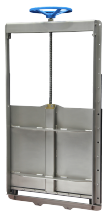Penstock valves are essential components in large water management systems, particularly in dams, water treatment plants, and irrigation systems. These valves regulate the flow of water in channels, pipes, or conduits by either fully opening or closing. They feature a sliding gate or blade mechanism that can be raised or lowered to control the water flow. Penstock valves are commonly used to divert, stop, or control the flow of water in various hydraulic structures. Their sturdy construction and ability to withstand high pressures and turbulent flows make them ideal for managing water resources effectively.



Penstock Valves
1 series from 1 manufacturers
The Operating Principles of a Penstock Valve
The operating principle of penstock valves revolves around their mechanism for controlling the flow of water. Penstock valves typically consist of a sliding gate or blade, which can be raised or lowered to either allow or block the passage of water through a channel, pipe, or conduit.
When the valve is in the closed position, the gate or blade sits firmly against the valve seat, effectively sealing off the flow of water. To open the valve, the gate or blade is lifted, allowing water to pass through the opening. Conversely, to close the valve, the gate or blade is lowered back into position, blocking the flow of water.
This operation is often facilitated by a mechanism such as a handwheel, gear, or hydraulic actuator, depending on the size and design of the valve. By adjusting the position of the gate or blade, operators can precisely control the flow of water, making penstock valves versatile and effective tools for managing large water systems.

Advantages & Disadvantages of Penstock Valves
These valves provide a reliable means of regulating water flow, ensuring efficient water distribution, flood control, and environmental management. However, like any mechanical system, penstock valves have their advantages and disadvantages that need to be carefully considered when selecting and implementing them in water infrastructure projects.
Advantages of Penstock Valves
- Precise Flow Control: Penstock valves offer precise control over the flow of water, allowing operators to adjust the flow rate as needed for various applications such as irrigation, water treatment, and flood control.
- Reliable Sealing: When closed, penstock valves provide a tight seal against the valve seat, preventing water leakage and ensuring efficient water management.
- Versatility: Penstock valves can be installed in a variety of settings, including dams, reservoirs, irrigation canals, and wastewater treatment plants, making them suitable for a wide range of water management applications.
- Durability: Constructed from robust materials such as stainless steel, cast iron, or ductile iron, penstock valves are highly durable and capable of withstanding harsh environmental conditions, including corrosion and abrasion.
Disadvantages of Penstock Valves
- Limited Flow Capacity: Penstock valves may have limitations in terms of their maximum flow capacity, particularly in larger diameter pipelines or high-flow applications, which could necessitate the use of multiple valves or larger valve sizes.
- Maintenance Requirements: Penstock valves require regular inspection and maintenance to ensure proper functioning and prevent issues such as corrosion, fouling, or mechanical wear. This maintenance can be labor-intensive and may require downtime for valve servicing.
- Operating Complexity: Depending on the design and size of the valve, operating penstock valves manually may require significant effort, particularly for larger valves or those located in remote or inaccessible locations. Automated penstock valves can mitigate this issue but may require additional infrastructure and maintenance.
- Risk of Blockages: Penstock valves with sliding gates or blades are susceptible to blockages from debris, sediment, or aquatic growth, which can impair valve operation and necessitate cleaning or clearing procedures to restore functionality.
Important Consideration when Selecting Penstock Valves
Selecting the right penstock valve is crucial for ensuring the efficient and reliable operation of water management systems. Various factors need to be considered to choose a valve that meets the specific requirements of the application, including:
- Operating Environment
Assess the environmental conditions where the penstock valve will be installed, including temperature variations, exposure to corrosive substances, and potential debris accumulation. Choose materials and coatings that can withstand these conditions to ensure long-term durability and reliability.
- Flow Requirements
Determine the required flow capacity and pressure rating based on the application's water flow rates and operating pressures. Select a penstock valve with the appropriate size and design to accommodate the expected flow conditions without causing excessive pressure drop or flow restriction.
- Valve Type and Configuration
Evaluate different types of penstock valves, such as rising stem, non-rising stem, sluice gate, and knife gate valves, to determine the most suitable option for the specific application. Consider factors such as sealing mechanism, actuation method, and space limitations to choose the optimal valve type and configuration.
- Actuation Method
Select the appropriate actuation method for the penstock valve, considering factors such as manual operation, electric actuation, hydraulic actuation, or pneumatic actuation. Evaluate the level of automation needed, accessibility of the valve, and control system compatibility to ensure smooth operation and control.
Why Buy Penstock Valves from AxFlow
AxFlow presents a specialized selection of penstock valves to meet various industrial needs. Our team, backed by years of experience, delivers tailored solutions and unbiased recommendations in penstock valve technology. Whether you require assistance in choosing, installing, or maintaining penstock valves, AxFlow's expert team is committed to providing unparalleled support and expertise in fluid control equipment. Reach out to AxFlow today for reliable solutions in penstock valve applications.



